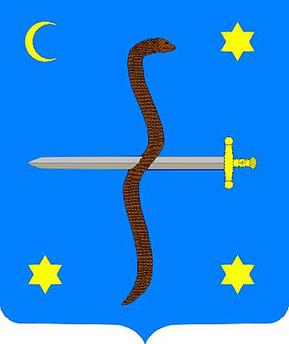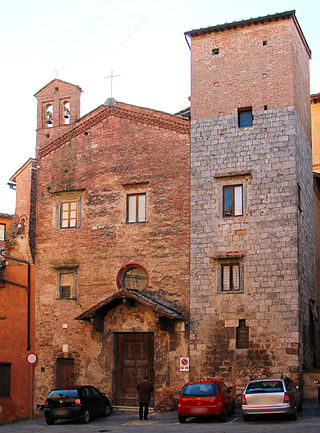
San Bernardino is a Romanesque-style, former Roman Catholic church building, for some decades converted to museum, in the town of Asciano, Province of Siena, region of Tuscany, Italy.

San Bernardino is a Romanesque-style, former Roman Catholic church building, for some decades converted to museum, in the town of Asciano, Province of Siena, region of Tuscany, Italy.
This church, was once an oratory or chapel, dedicated to San Giovanni Battista, adjacent to the church of San Francesco. It was property of a hospital of San Giovanni Battista at the site since 1178. The oratory was restored in 1324 by the Commendatore Federigo Spadafuori. It acquired the new title in 1444, with a visit from Bernardino da Siena. [1] In the 15th century it was owned by the Knights Hospitaller. [2]

Asciano is a comune and hill town in the province of Siena in the Italian region Tuscany. It is located at the centre of the Crete senesi between the river Ombrone and the torrent Copra, some 30 kilometres (19 mi) southeast of the town of Siena by rail.

Castelnuovo Berardenga is a comune (municipality) in the province of Siena in the Italian region Tuscany, located about 50 kilometres (31 mi) southeast of Florence and about 14 kilometres (9 mi) east of Siena. Since 1932 it has been included in the Chianti wine-production area.

San Quirico d'Orcia is a comune (municipality) of about 2,500 inhabitants in the Province of Siena in the Italian region Tuscany, located about 80 kilometres (50 mi) southeast of Florence and about 35 kilometres (22 mi) southeast of Siena inside the Valdorcia landscape. It is named in honor of Saint Quiricus.

Trequanda is a comune (municipality) in the Province of Siena in the Italian region Tuscany, located about 70 kilometres (43 mi) southeast of Florence and about 30 kilometres (19 mi) southeast of Siena.

Campagnatico is a comune (municipality) in the Province of Grosseto in the Italian region Tuscany, located about 100 kilometres (62 mi) south of Florence and about 20 kilometres (12 mi) northeast of Grosseto in the valley of the Ombrone River.

Matteo di Giovanni was an Italian Renaissance artist from the Sienese School.

The Basilica of San Domenico, also known as Basilica Cateriniana, is a basilica church in Siena, Tuscany, Italy, one of the most important in the city. The basilica is an example of Cistercian Gothic style.

The Vegni are an Italian family from Siena. The medieval origins of the family have limited documentation. The origin of the family is in Siena, with Bencivenne, father of Aringhieri, whose children Guido, Iacobina and Ranieri are mentioned in a contract of a house sale in 1201. The son of Guido, Bencivenni, is the first one to have a recognised profession mentioned in the documents. A notary of the royal chamber, called Bencivennis olim Guidi, was active in Siena in the first part of the 13th century. The patronymic Bencivennis is used, abbreviated as bcVennis in the documents signed by Luca, a notary, in documents he drew up during late 13th. Pietro olim (of) Luca bcVennis was active in Siena until 1321. The sons of Pietro settled in the area of Chianciano, focusing the centre of interests of the family in the South of the Siena Republic until the fall of it in 1555. The surname Bencivennis remains in official documents during all the Republican period, to disappear at the end of the 16th century, substituted by Vegni. The last one to use it in official documents is Eustachio Bencivennis or bcVegnis, again a notary, who died in 1585. His grandson Giovanni Battista di Pietro, a notary in Chianciano between 1600 and 1641, signs his documents as Vegni, although he still uses the same private legal seal with the family coat of arms.

The Basilica dell'Osservanza is a church on the outskirts of Siena, region of Tuscany, Italy.
Santa Lucia is a Baroque style church, located in the piazza of the same name in the town of Montepulciano, Province of Siena, Region of Tuscany.

Santa Maria in Provenzano, or the Insigne Collegiata di Santa Maria in Provenzano, is a late-Renaissance-Baroque style, Roman Catholic, collegiate church in Piazza Provenzano Salvani, in the Terza Camollia, just southwest of the basilica of San Francesco, in the city of Siena, region of Tuscany, Italy. This Marian shrine was built around a 14th-century terracotta icon of the Madonna, which was credited with miracles. The Palio of Siena takes place on the day of veneration of this Marian devotion.

San Giovannino della Staffa, also known as San Giovannino in Pantaneto is a Renaissance style Roman Catholic church on Piazetta Virgilio Grassi, in the Contrada del Leocorno, Siena, Tuscany, Italy.

San Vigilio is a Renaissance and Baroque style, Roman Catholic church located on Via San Vigilio, Siena, region of Tuscany, Italy. The exterior has a sober classical facade, while the interior has rich Baroque decorations. The church is dedicated to the Bishop and martyr St Vigilius; it now serves as the chapel for the University of Siena. It stands across the street from the Castellare Ugurgieri, and down the street from the Palazzo Bandini Piccolomini found on the junction with Via Sallustio Bandini.

The Church of the Jail of Sant'Ansano, Italian: Chiese delle Carceri di Sant'Ansano, also known as the Chapel or Oratory of Sant'Ansano in Castelvecchio, is a small, medieval, Roman Catholic religious building located on via Tommaso Pendola in the Terzo di Città of the city of Siena, region of Tuscany, Italy. Adjacent to the tower is the former Istituto Santa Teresa.

Santi Stefano e Niccolao or Stefano e Nicolò is a Roman Catholic church located in Pescia, region of Tuscany, Italy.

Santa Margherita is a Baroque-style, Roman Catholic church and convent located on Vittorio Emanuele #80 in the town of Chieri, Province of Turin, region of Piedmont, Italy.

San Michele e San Francesco is a renaissance-style, Roman Catholic parish church located in the Piazza SS Francesco e Michele in the town of Carmignano, province of Prato, region of Tuscany, Italy. It is best known for housing the Jacopo Pontormo altarpiece of the Visitation.
The Master of Staffolo was an anonymous late-Gothic style painter active in the region of Marche and Umbria.

San Francesco is a Gothic-style, deconsecrated Roman Catholic church located on Piazza San Francesco in the medieval center of the city of Rieti, region of Lazio, Italy.

Pievina is a village in Tuscany, central Italy, in the comune of Asciano, province of Siena. At the time of the 2018 parish census its population was 97.